Automating the hybrid laser welding technology brings many benefits to the fabrication industry. The labor costs go down while the production rates and weld quality significantly increase.
This technology allows many industries to flourish as stagnant design limits are breached.
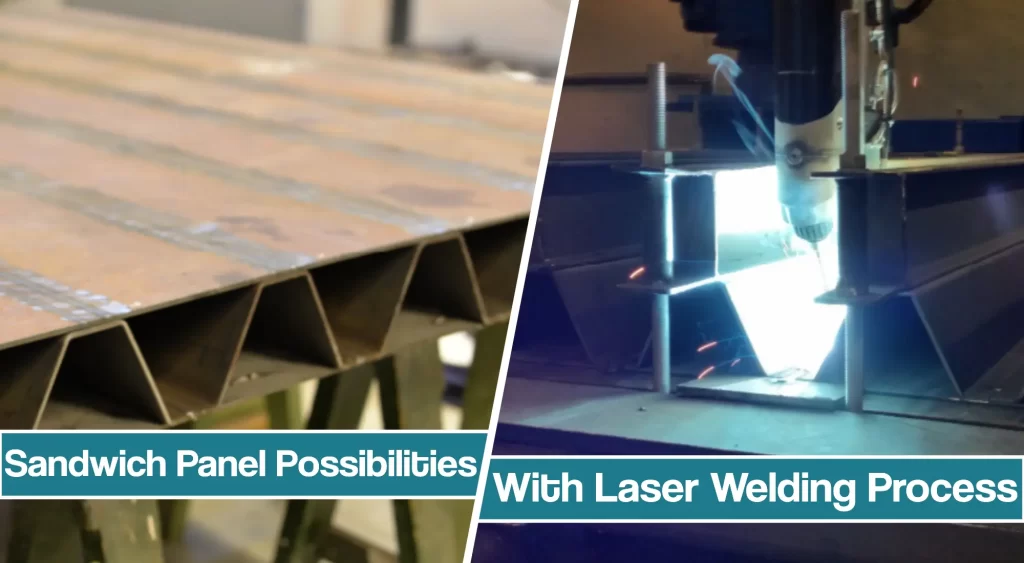
In this article, we will look at the new design implications of sandwich panels that are possible thanks to the hybrid laser welding technology.
What Is Hybrid Laser Welding
Hybrid laser welding combines the principles of laser beam welding and arc welding. This hybrid process has three main types, depending on the arc welding method. It can be used with TIG, plasma arc, and MIG.
The MIG arc welding method is most commonly used with a laser as a hybrid welding process in industrial applications. The spray transfer mode works the best. It sends a spray of tiny molten droplets across the arc, and the laser’s tightly focused beam and energy density stabilize the arc.
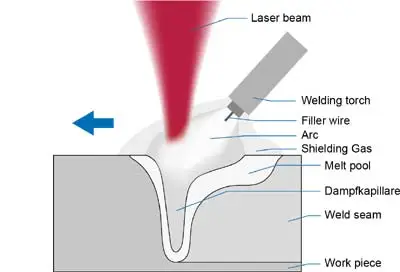
Additionally, the laser welding component provides deep penetration and minimizes the heat affected zone (“HAZ”), thanks to the very low and focused heat input. The weld metallurgy is significantly improved with the addition of the MIG welding process compared to welding with laser only. That’s because it substantially improves the tolerance of joint gaps, surface conditions and impurities. It also enhances gap contouring and filling.
The best hybrid laser take was achieved by ESAB. They produced a cost-effective way to weld beams from high strength plates for use in shipbuilding, and it became commercially available.
ESAB’s Hybrio – Hybrid laser welding provides up to 1000% increase in productivity, significant reduction in costs, and heat-related defects.
ESAB’s systems have welded beams from high strength and standard steel 5 to 10 times faster than what’s possible with typical welding processes. Plus, the finished product had tolerances that were ¼ to 1/10 of the allowed tolerances for hot rolled beams.
Extensive testing was done to measure the effectiveness of the hybrid laser welding process. The end result is that the laser-welded structures perform as good or better than traditionally welded structures. Plus, it was proven that hybrid laser welding achieves fatigue lives that are 2 to 3 times longer than standard GMAW and submerged arc welding processes provide.
Sandwich Panels Maximize Strength & Stiffness; Minimize Weight
Hybrid laser welding finds excellent use in manufacturing various sandwich panels. It makes their production economical, fast, and with little to no welding defects.
Sandwich panels are defined as a three-layer structure that consists of two thin, outer layers of high-strength material with a low-density and low-weight inner core material.
The core material separates the two face sheets and serves as a filler, and insulating material, and can be used in various ways, as we will discuss soon. The two outer sheets provide the most strength to the structure and sustain the physical loads.
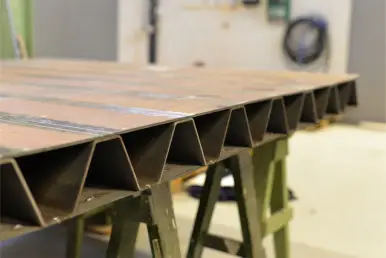
This combination produces sandwich panels with favorable stiffness and weight characteristics. The sandwich panel core can be made of various materials and shapes. The most common core sandwich structure is corrugated, similar to corrugated cardboard.
The conventional welding methods have hindered the development of all-metal sandwich panels. That’s why until the hybrid laser welding process proved sufficient, the majority of sandwich structures were designed with fiber-reinforced polymer composite or metallic skins adhered to structural foam, elastomeric cores, or wood.
Shipbuilding
Actually, the first metal sandwich panels were designed for shipbuilding in the 1980s, but their research and development were abandoned. There was no manufacturing system that could mass-produce such panels in an economical manner.
However, as hybrid laser welding became viable, the shipbuilders have re-engaged the efforts to develop metal sandwich panels subjected to loads on ships.
It has been more than 20 years since the European shipbuilding industry, in cooperation with many universities and research institutes, took an interest in the sandwich panel design.
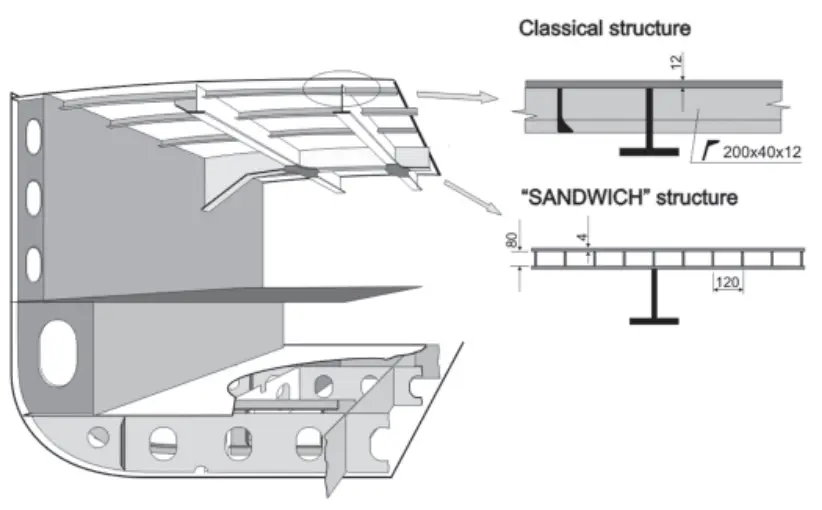
There has been a significant advance in understanding the behavioral characteristics and advantages of laser-welded steel sandwich panels.
First-panel university studies focused on prototypes for ship decks. However, it wasn’t long until there was a strong interest for broader applications, especially in the transportation industry.
The multi-industry consortium studied the technology of sandwich panels, and their work resulted in the following advantages of sandwich panel structures:
- Up to 50% weight reduction compared to traditional steel construction technology
- 90% reduction in weight than concrete structures
- 2/3 reduction in structural space requirements
- Extremely improved fire resistance when appropriate filler material is used
- Improved energy absorption capability and damage tolerance
What followed was the adoption of steel sandwich panels for manufacturing lightweight decks and stairs in cruise ships, lightweight balconies, and multi-level flooring.
Construction Industry
The steel sandwich panel can span longer distances than a typical steel panel thanks to its mechanical properties, namely its stiffness. Combining the increased span and significantly decreased weight, reduces the construction cost. But it also increases the building value.
Let’s take a look at the following example:
A commercial, multi-story building like a shopping mall benefits from each additional floor and square foot of commercial area. If the sandwich panels are used as floor decking, the floors will have a significantly lower weight than the traditional structures. As a result, the height of steel I-beams reduces, and so does their weight. This weight reduction requires lighter columns and smaller foundations.
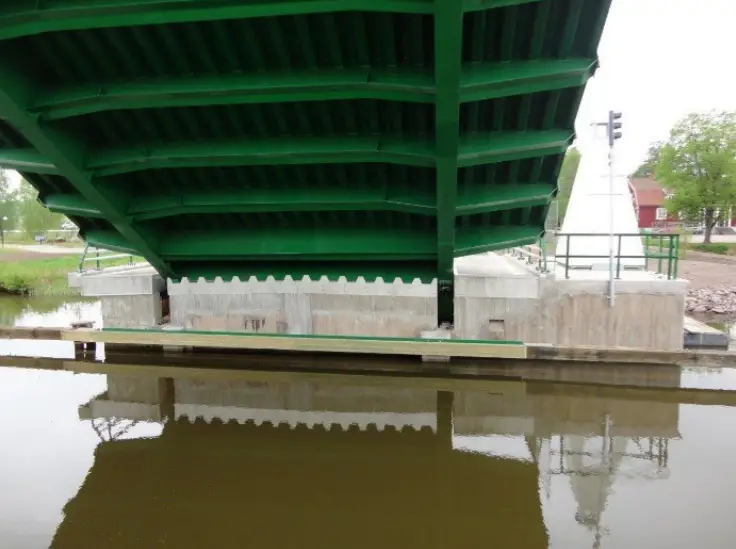
bridge application by Peter Nilsson
Each of these reductions in size reduces the construction costs, but it also increases the size of the usable area of the building. Higher floors, or more floors, increasing the rentable area.
Additionally, the inner core material is perfect for running installations through the building. Electrical, optical, and ventilation can efficiently be installed in the core material, depending on the core height.
The core material can be fireproof, which increases the level of fire resistance and can further cut down on the costs of maintaining such a shopping mall from our example. The need for complex fire systems may reduce depending on other factors like local regulations.
Besides the use in commercial or residential buildings, the sandwich panels can find use in civil engineering, particularly in bridge construction. Their strength and design optimization for length make them particularly competitive with conventional bridge construction systems.
Transportation Industry
The transportation industry benefits greatly from the sandwich panels. The truck trailers, van side panels, railcars, shipping containers, and others benefit from reduced weight and increased strength.
The reduced weight of the vehicle means lower fuel consumption. This is particularly important from the ecological point of view and the ever-increasing regulatory demand for lower carbon emissions. This even holds true for electric vehicles. Their battery can sustain longer if the vehicle itself is lighter.
On the other hand, a lighter vehicle means more revenue per traveled mile and per pound of transported weight. The lower the fuel cost, the better for the contractor. Additionally, if the weight is reduced on the chassis and other essential vehicle elements, there will be fewer repairs and maintenance schedules, further decreasing the costs.
So, the hybrid laser technology that allows us to weld such panels increases efficiency even in less obvious industries. It’s not just the construction industry that can benefit.
There are also some crucial hidden benefits as well. Such panels used in transportation can handle impact load much better than conventional construction methods. If damaged, the load tends to redistribute, and the panel absorbs the crash energy, protecting the passengers and the cargo.
Additional Advantages of Hybrid Laser Welded Panels
- The hybrid laser welded panels exhibit exceptional straightness and flatness and provide superior cosmetic characteristics
- These panels have a completely smooth surface
- Production is fully automated, cutting the labor costs
- Almost all metals are suitable for panels
- It’s possible to achieve similar structural efficiency as with the aluminum when using plain steel
Conclusion
The hybrid laser welding method is not new, but its application has paved the way for technology advancements in seemingly unrelated fields. These panels are the best example of how a simple change of a joining method can translate to significantly improved efficiency across various industries.
Welding is a part of almost every industry in the world. As you are reading this article right now, the chances are good that no item in your vicinity hasn’t been influenced by the efficiency of some welding process. That is why innovation in the welding space is so important. Everything can change for the better if we understand and utilize the processes like hybrid laser welding.
Sources:
- Hybrid laser welding at TWI-global
- Welding Principles and Applications by Larry Jeffus
- Laser-welded corrugated core steel sandwich panels for bridge application by Piter Nilsson





